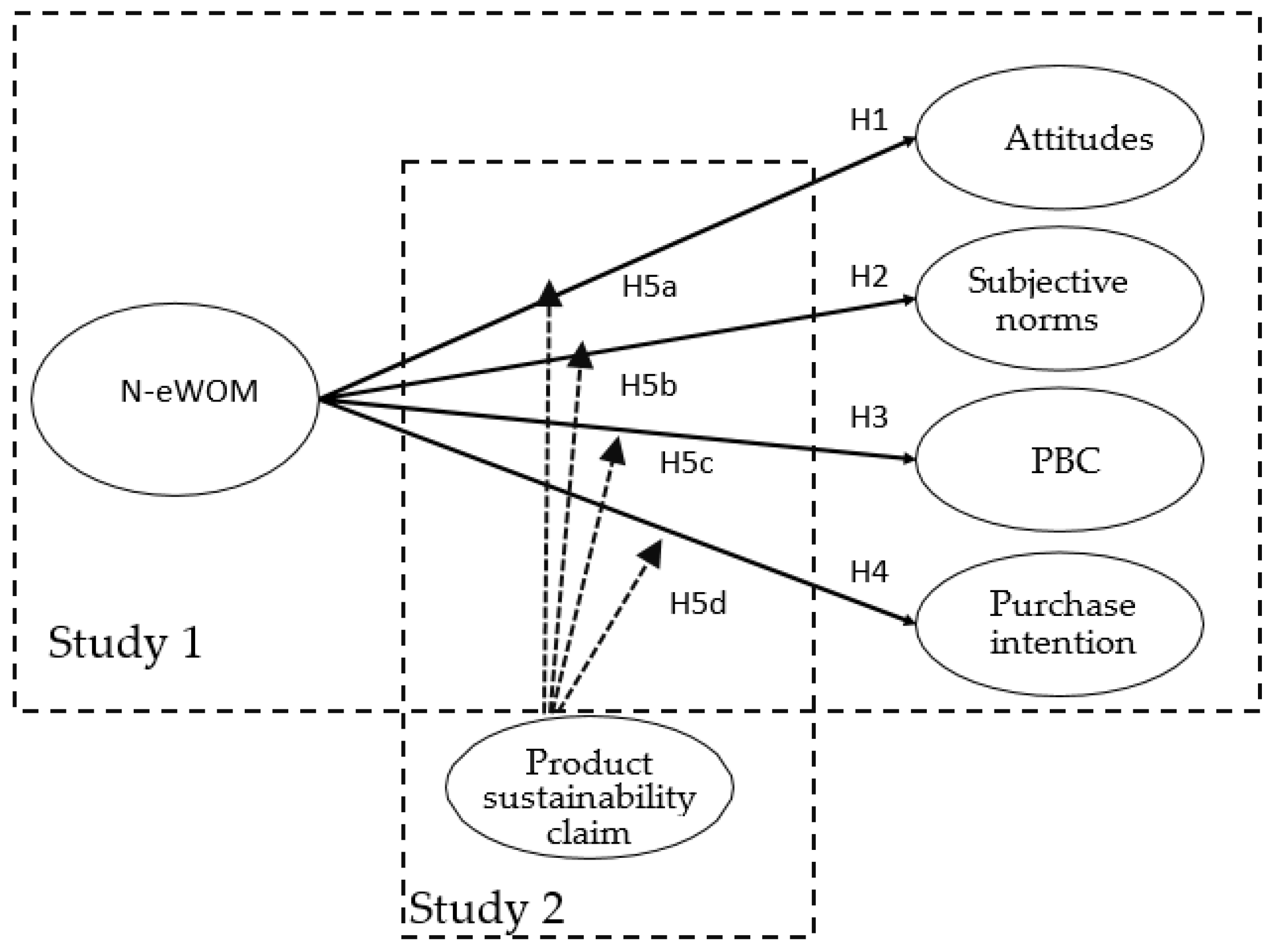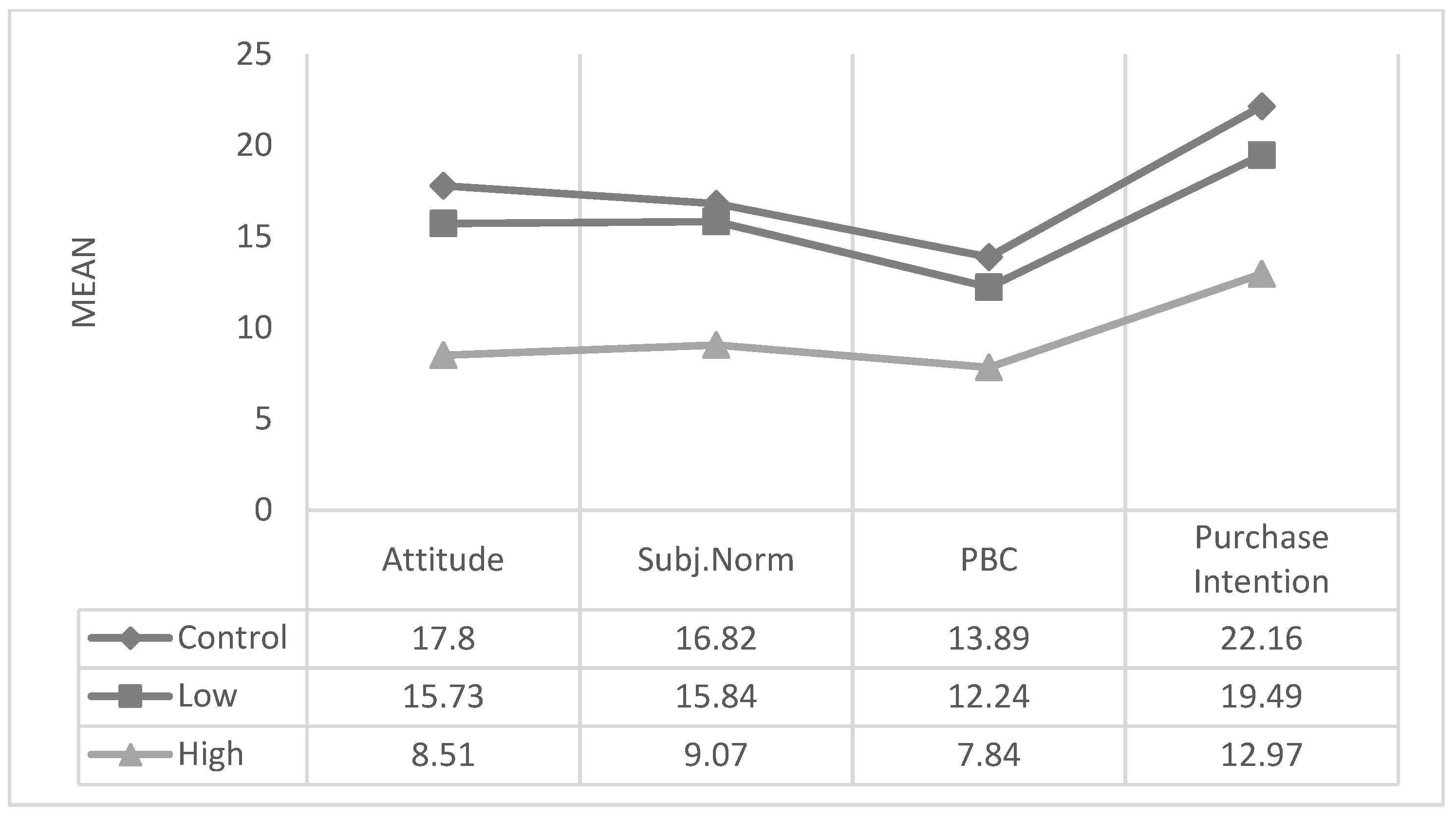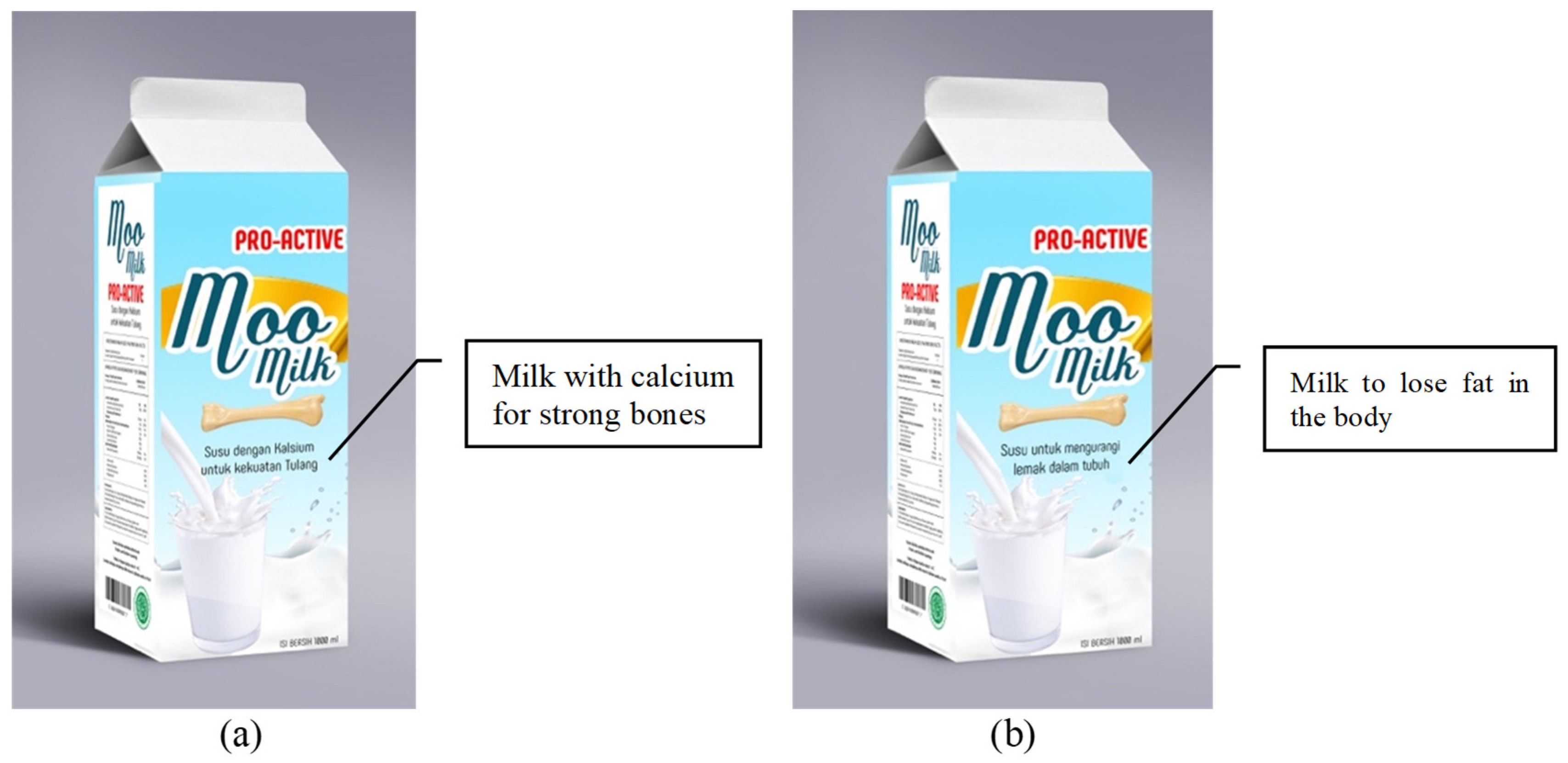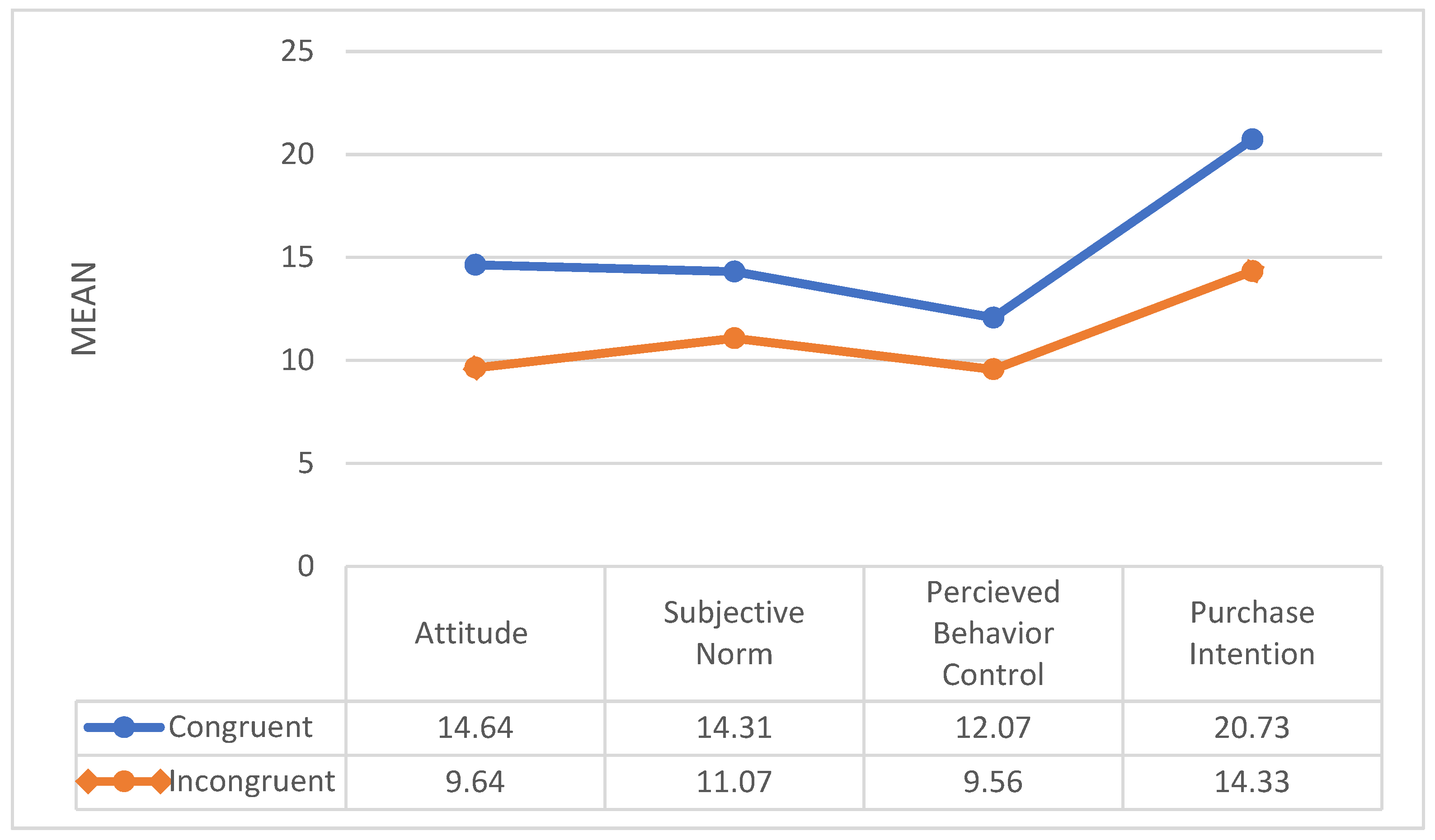The Effectiveness of Product Sustainability Claims to Mitigate Negative Electronic Word of Mouth (N-eWOM)
Abstract
1. Introduction
2. Theoretical Background and Hypothesis
2.1. Product Sustainability
2.2. The Theory of Planned Behavior and Negative eWOM
2.3. Product Claims
3. Study 1: The Effect of Negative eWOM
3.1. Method
3.2. Stimulus Development
3.3. Measurement of the Dependent Variable
3.4. Results
3.5. Discussion
4. Study 2: The Effect of Product Sustainability Claims
4.1. Method
4.2. Stimulus Development
4.3. Procedure and Result
4.4. Discussion
5. Conclusions and Limitations
5.1. Conclusions
5.2. Managerial Implications
5.3. Limitations and Future Research
Author Contributions
Funding
Institutional Review Board Statement
Informed Consent Statement
Data Availability Statement
Acknowledgments
Conflicts of Interest
References
- Saeed, M.A.; Farooq, A.; Kersten, W.; Ben Abdelaziz, S.I. Sustainable product purchase: Does information about product sustainability on social media affect purchase behavior? Asian J. Sustain. Soc. Responsib. 2019, 4, 9. [Google Scholar] [CrossRef]
- Hennig-Thurau, T.; Gwinner, K.P.; Walsh, G.; Gremler, D.D. Electronic word-of-mouth via consumer-opinion platforms: What motivates consumers to articulate themselves on the Internet? J. Interact. Mark. 2004, 18, 38–52. [Google Scholar] [CrossRef]
- Park, D.H.; Lee, J.; Han, I. The effect of on-line consumer reviews on consumer purchasing intention: The moderating role of involvement. Int. J. Electron. Commer. 2007, 11, 125–148. [Google Scholar] [CrossRef]
- Fu, X.; Zhang, B.; Xie, Q.; Xiao, L.; Che, Y. Impact of Quantity and Timeliness of EWOM Information on Consumer’s Online Purchase Intention under C2C Environment. Asian J. Bus. Res. 2011, 1, 37–52. [Google Scholar] [CrossRef]
- Hsu, C.L.; Lin, J.C.C.; Chiang, H.S. The effects of blogger recommendations on customers’ online shopping intentions. Internet Res. 2013, 23, 69–88. [Google Scholar] [CrossRef]
- Gildin, S.Z. Understanding the power of word-of-mouth. RAM Rev. Adm. Mackenzie 2003, 4, 92–106. [Google Scholar]
- Dellarocas, C. The digitization of word of mouth: Promise and challenges of online feedback mechanisms. Manag. Sci. 2003, 49, 1407–1424. [Google Scholar] [CrossRef]
- Radighieri, J.P.; Mulder, M. The impact of source effects and message valence on word of mouth retransmission. Int. J. Mark. Res. 2013, 56, 249–263. [Google Scholar] [CrossRef]
- Kotler, P.; Armstrong, G. Principles of Marketing, 17th ed.; Pearson Australia: Melbourne, Australia, 2018; ISBN 9780134492513. [Google Scholar]
- Lau, G.T.; Ng, S. Individual and situational factors influencing negative word-of-mouth behaviour. Can. J. Adm. Sci. 2001, 18, 163–178. [Google Scholar] [CrossRef]
- Cui, G.; Lui, H.K.; Guo, X. The effect of online consumer reviews on new product sales. Int. J. Electron. Commer. 2012, 17, 39–58. [Google Scholar] [CrossRef]
- Chevalier, J.; Mayzlin, D. The effect of word of mouth on sales online book reviews. J. Mark. Res. 2006, XLIII, 345–354. [Google Scholar] [CrossRef]
- Zhu, F.; Zhang, X.M. Impact of online consumer reviews on sales: The moderating role of Product and consumer characteristic. J. Mark. 2010, 74, 133–148. [Google Scholar] [CrossRef]
- East, R.; Hammond, K.; Gendall, P. Fact and Fallacy in Retention Marketing. J. Mark. Manag. 2006, 22, 5–23. [Google Scholar] [CrossRef]
- Cheng, S.; Lam, T.; Hsu, C.H.C. Negative Word-of-Mouth Communication Intention: An Application of the Theory of Planned Behavior. J. Hosp. Tour. Res. 2006, 30, 95–116. [Google Scholar] [CrossRef]
- Wangenheim, F.; Bayon, T. The effect of word of mouth on services switching Measurement and moderating variables. Eur. J. Mark. 2004, 38, 1173–1185. [Google Scholar] [CrossRef]
- Sen, S.; Lerman, D. Why are you telling me this? An examination into negative consumer reviews on the web. J. Interact. Mark. 2007, 21, 76–94. [Google Scholar] [CrossRef]
- Gu, B.; Tang, Q.; Whinston, A.B. The influence of online word-of-mouth on long tail formation. Decis. Support Syst. 2013, 56, 474–481. [Google Scholar] [CrossRef]
- Park, D.H.; Kim, S. The effects of consumer knowledge on message processing of electronic word-of-mouth via online consumer reviews. Electron. Commer. Res. Appl. 2008, 7, 399–410. [Google Scholar] [CrossRef]
- Bhandari, M.; Rodgers, S. What does the brand say? Effects of brand feedback to negative eWOM on brand trust and purchase intentions. Int. J. Advert. 2018, 37, 125–141. [Google Scholar] [CrossRef]
- Sparks, B.A.; Bradley, G.L. A “Triple A” Typology of Responding to Negative Consumer-Generated Online Reviews. J. Hosp. Tour. Res. 2017, 41, 719–745. [Google Scholar] [CrossRef]
- Lee, C.H.; Cranage, D.A. Toward Understanding Consumer Processing of Negative Online Word-of-Mouth Communication: The Roles of Opinion Consensus and Organizational Response Strategies. J. Hosp. Tour. Res. 2014, 38, 330–360. [Google Scholar] [CrossRef]
- Dyllick, T.; Rost, Z. Towards true product sustainability. J. Clean. Prod. 2017, 162, 346–360. [Google Scholar] [CrossRef]
- He, B.; Luo, T.; Huang, S. Product sustainability assessment for product life cycle. J. Clean. Prod. 2019, 206, 238–250. [Google Scholar] [CrossRef]
- Petersen, M.; Brockhaus, S. Dancing in the dark: Challenges for product developers to improve and communicate product sustainability. J. Clean. Prod. 2017, 161, 345–354. [Google Scholar] [CrossRef]
- Gebisa, A.W.; Lemu, H.G. Design for manufacturing to design for Additive Manufacturing: Analysis of implications for design optimality and product sustainability. Procedia Manuf. 2017, 13, 724–731. [Google Scholar] [CrossRef]
- Kusumawati, A.; Utomo, H.S.; Suharyono, S.; Sunarti, S. Effects of sustainability on WoM intention and revisit intention, with environmental awareness as a moderator. Manag. Environ. Qual. An Int. J. 2020, 31, 273–288. [Google Scholar] [CrossRef]
- Reichheld, F.F.; Teal, T. The Loyalty Effect: The Hidden Force Behind Growth, Profits, and Lasting Value Location; Harvard Business School Publications: Boston, MA, USA, 2001; ISBN 9781578516872. [Google Scholar]
- Erraach, Y.; Jaafer, F.; Radi, I. Sustainability Labels on Olive Oil: A Review on Consumer Attitudes and Behavior. Sustainability 2021, 13, 12310. [Google Scholar] [CrossRef]
- Malcorps, W.; Newton, R.W.; Maiolo, S.; Eltholth, M.; Zhu, C.; Zhang, W.; Li, S.; Tlusty, M.; Little, D.C. Global Seafood Trade: Insights in Sustainability Messaging and Claims of the Major Producing and Consuming Regions. Sustainability 2021, 13, 11720. [Google Scholar] [CrossRef]
- Muñoz, N.; Ignacio, J.; Mart, V.; Fern, A.; Biedermann, A.; Luis, J.; Santolaya, S. Projecting More Sustainable Product and Service Designs. Sustainability 2021, 13, 11872. [Google Scholar] [CrossRef]
- Ilie, D.M.; Lădaru, G.R.; Diaconeasa, M.C.; Stoian, M. Consumer choice for milk and dairy in romania: Does income really have an influence? Sustainability 2021, 13, 12204. [Google Scholar] [CrossRef]
- Moreno-Villares, J.M. Milk and dairy products: Good or bad for human health? An assessment of the totality of scientific evidence. Acta Pediatr. Esp. 2016, 74, e258. [Google Scholar]
- Xu, J.; Wang, J.; Li, C. Impact of Consumer Health Awareness on Dairy Product Purchase Behavior during the COVID-19 Pandemic. Sustainability 2022, 14, 314. [Google Scholar] [CrossRef]
- Carlsson Kanyama, A.; Hedin, B.; Katzeff, C. Differences in environmental impact between plant-based alternatives to dairy and dairy products: A systematic literature review. Sustainability 2021, 13, 12599. [Google Scholar] [CrossRef]
- Chalupa-Krebzdak, S.; Long, C.J.; Bohrer, B.M. Nutrient density and nutritional value of milk and plant-based milk alternatives. Int. Dairy J. 2018, 87, 84–92. [Google Scholar] [CrossRef]
- Rahmana, A.; Daryanto, A.; Jahroh, S. Sustainability Strategies of Indonesian Mega-Dairy Farm Business: A Case of Greenfields Indonesia. J. Manaj. Dan Agribisnis 2018, 15, 162–171. [Google Scholar] [CrossRef][Green Version]
- Ahmmadi, P.; Rahimian, M.; Movahed, R.G. Theory of planned behavior to predict consumer behavior in using products irrigated with purified wastewater in Iran consumer. J. Clean. Prod. 2021, 296, 126359. [Google Scholar] [CrossRef]
- Mohebi, S.; Parham, M.; Sharifirad, G.; Gharlipour, Z. Application of the theory of planned behavior in the design and implementation of a behavior-based safety plan in the workplace. J. Educ. Health Promot. 2021, 10, 1–7. [Google Scholar] [CrossRef]
- Fan, C.W.; Chen, I.H.; Ko, N.Y.; Yen, C.F.; Lin, C.Y.; Griffiths, M.D.; Pakpour, A.H. Extended theory of planned behavior in explaining the intention to COVID-19 vaccination uptake among mainland Chinese university students: An online survey study. Hum. Vaccines Immunother. 2021, 17, 3413–3420. [Google Scholar] [CrossRef]
- Bagheri, A.; Emami, N.; Damalas, C.A. Farmers’ behavior towards safe pesticide handling: An analysis with the theory of planned behavior. Sci. Total Environ. 2021, 751, 141709. [Google Scholar] [CrossRef]
- Lim, H.R.; An, S. Intention to purchase wellbeing food among Korean consumers: An application of the Theory of Planned Behavior. Food Qual. Prefer. 2021, 88, 104101. [Google Scholar] [CrossRef]
- Yeh, S.S.; Guan, X.; Chiang, T.Y.; Ho, J.L.; Huan, T.C.T. Reinterpreting the theory of planned behavior and its application to green hotel consumption intention. Int. J. Hosp. Manag. 2021, 94, 102827. [Google Scholar] [CrossRef]
- Ataei, P.; Gholamrezai, S.; Movahedi, R.; Aliabadi, V. An analysis of farmers’ intention to use green pesticides: The application of the extended theory of planned behavior and health belief model. J. Rural Stud. 2021, 81, 374–384. [Google Scholar] [CrossRef]
- Du, J.; Pan, W. Examining energy saving behaviors in student dormitories using an expanded theory of planned behavior. Habitat Int. 2021, 107, 102308. [Google Scholar] [CrossRef]
- Moon, S.J. Investigating beliefs, attitudes, and intentions regarding green restaurant patronage: An application of the extended theory of planned behavior with moderating effects of gender and age. Int. J. Hosp. Manag. 2021, 92, 102727. [Google Scholar] [CrossRef]
- Liu, X.; Wang, Q.C.; Jian, I.Y.; Chi, H.L.; Yang, D.; Chan, E.H.W. Are you an energy saver at home? The personality insights of household energy conservation behaviors based on theory of planned behavior. Resour. Conserv. Recycl. 2021, 174, 105823. [Google Scholar] [CrossRef]
- Wang, Y.; Long, X.; Li, L.; Wang, Q.; Ding, X.; Cai, S. Extending theory of planned behavior in household waste sorting in China: The moderating effect of knowledge, personal involvement, and moral responsibility. Environ. Dev. Sustain. 2021, 23, 7230–7250. [Google Scholar] [CrossRef]
- Anrisevdİ, A.T.; Ul, G.Ö.; Güçlütü, G.; Baran, R.K. Examining Traditional Wom Intention In The Context Of Theory Of Planned Behavior: A Case Of Turkish Mountaineers. ASBİ Abant. Sos. Bilim. Derg. 2021, 21, 63–89. [Google Scholar]
- Soliman, M. Extending the Theory of Planned Behavior to Predict Tourism Destination Revisit Intention. Int. J. Hosp. Tour. Adm. 2021, 22, 524–549. [Google Scholar] [CrossRef]
- Bachleda, C.; Berrada-Fathi, B. Is negative eWOM more influential than negative pWOM? J. Serv. Theory Pract. 2016, 26, 109–132. [Google Scholar] [CrossRef]
- Kudhesia, C.; Kumar, A. Social eWOM: Does it affect the brand attitude and purchase intention of brands? Manag. Res. Rev. 2017, 40, 310–330. [Google Scholar] [CrossRef]
- Wiederhold, M.; Martinez, L.F. Ethical consumer behaviour in Germany: The attitude-behaviour gap in the green apparel industry. Int. J. Consum. Stud. 2018, 42, 419–429. [Google Scholar] [CrossRef]
- Vermeulen, I.E.; Seegers, D. Tried and tested: The impact of online hotel reviews on consumer consideration. Tour. Manag. 2009, 30, 123–127. [Google Scholar] [CrossRef]
- Ajzen, I. The Theory of Planned Behavior. Organ. Behav. Hum. Decis. Process. 1991, 50, 179–211. [Google Scholar] [CrossRef]
- Jalilvand, M.R.; Samiei, N. The impact of electronic word of mouth on a tourism destination choice: Testing the theory of planned behavior (TPB). Internet Res. 2012, 22, 591–612. [Google Scholar] [CrossRef]
- Hogg, M.A.; Vaughan, G.M. Social Psychology, 8th ed.; Basic Books: New York, NY, USA, 2018; ISBN 9781292090450. [Google Scholar]
- Beck, L.; Ajzen, I. Predicting dishonest actions using the theory of planned behavior. J. Res. Pers. 1991, 25, 285–301. [Google Scholar] [CrossRef]
- Chen, Z.; Lurie, N.H. Temporal contiguity and negativity bias in the impact of online word of mouth. J. Mark. Res. 2013, 50, 463–476. [Google Scholar] [CrossRef]
- Jalilvand, M.R.; Samiei, N. The effect of electronic word of mouth on brand image and purchase intention: An empirical study in the automobile industry in Iran. Mark. Intell. Plan. 2012, 30, 460–476. [Google Scholar] [CrossRef]
- Lee, J.; Park, D.H.; Han, I. The effect of negative online consumer reviews on product attitude: An information processing view. Electron. Commer. Res. Appl. 2008, 7, 341–352. [Google Scholar] [CrossRef]
- Doh, S.J.; Hwang, J.S. How Consumers Evaluate eWOM. Cyberpsychol. Behav. 2009, 12, 193–197. [Google Scholar] [CrossRef]
- Sparks, B.A.; Browning, V. The impact of online reviews on hotel booking intentions and perception of trust. Tour. Manag. 2011, 32, 1310–1323. [Google Scholar] [CrossRef]
- Wu, P.C.S.; Wang, Y.C.; Wang, Y. The influences of electronic word-of-mouth message appeal and message source credibility on brand attitude. Asia Pac. J. Mark. Logist. 2011, 23, 448–472. [Google Scholar] [CrossRef]
- Van Ooijen, I.; Fransen, M.L.; Verlegh, P.W.J.; Smit, E.G. Atypical food packaging affects the persuasive impact of product claims. Food Qual. Prefer. 2016, 48, 33–40. [Google Scholar] [CrossRef]
- Slavin, J.L.; Jacobs, D.; Marquart, L.; Wiemer, K. The role of whole grains in disease prevention. J. Am. Diet. Assoc. 2001, 101, 780–785. [Google Scholar] [CrossRef]
- Grunert, K.G.; Wills, J.M.; Fernández-Celemín, L. Nutrition knowledge, and use and understanding of nutrition information on food labels among consumers in the UK. Appetite 2010, 55, 177–189. [Google Scholar] [CrossRef] [PubMed]
- Chen, M. Modeling an extended theory of planned behavior model to predict intention to take precautions to avoid consuming food with additives. Food Qual. Prefer. 2017, 58, 24–33. [Google Scholar] [CrossRef]
- Castro, C. The Effect of Using Claim Confirming Product Cues on the Product Claim Credibility: Is Seeing Believing? Ph.D. Thesis, Escola de Administração de Empresas de São Paulo, São Paulo, Brazil, 2013. [Google Scholar]
- Sirgy, M.J. Self-congruity theory in consumer behavior: A little history. J. Glob. Sch. Mark. Sci. 2018, 28, 197–207. [Google Scholar] [CrossRef]
- Stayman, D.M.; Alden, D.L.; Smith, K.H. Some Effects of Schematic Processing on Consumer Expectations and Disconfirmation Judgments. J. Consum. Res. 1992, 19, 240. [Google Scholar] [CrossRef]
- Sherman, S.J.; Zehner, K.S.; Johnson, J.; Hirt, E.R. Social explanation: The role of timing, set, and recall on subjective likelihood estimates. J. Pers. Soc. Psychol. 1983, 44, 1127–1143. [Google Scholar] [CrossRef]
- Haas, R.; Schnepps, A.; Pichler, A.; Meixner, O. Cow milk versus plant-based milk substitutes: A comparison of product image and motivational structure of consumption. Sustainability 2019, 11, 5046. [Google Scholar] [CrossRef]
- McCarthy, K.S.; Parker, M.; Ameerally, A.; Drake, S.L.; Drake, M.A. Drivers of choice for fluid milk versus plant-based alternatives: What are consumer perceptions of fluid milk? J. Dairy Sci. 2017, 100, 6125–6138. [Google Scholar] [CrossRef]
- Taylor, S.; Todd, P. Decomposition and crossover effects in the theory of planned behavior: A study of consumer adoption intentions. Int. J. Res. Mark. 1995, 12, 137–155. [Google Scholar] [CrossRef]
- Ybarra, O.; Trafimow, D. How Priming the Private Self or Collective Self Affects the Relative Weights of Attitudes and Subjective Norms. Personal. Soc. Psychol. Bull. 1998, 24, 362–370. [Google Scholar] [CrossRef]
- Hair, J.F.J.; Black, W.C.; Babin, B.J.; Anderson, R.E.; Black, W.C.; Anderson, R.E. Multivariate Data Analysis; Springer Science & Business Media: Berlin/Heidelberg, Germany, 2018; ISBN 9781473756540. [Google Scholar]
- Yu, Z. The Effects of Congruency in Product-Claim-Package on Consumers’ Perception and Purchase Intention. Master Thesis, Wageningen University, Wageningen, The Netherlands, 2015. [Google Scholar]
- Yoon, H.J. Understanding schema incongruity as a process in advertising: Review and future recommendations. J. Mark. Commun. 2013, 19, 360–376. [Google Scholar] [CrossRef]
- Smith, R.E.; Vogt, C.A. The Effects of Integrating Advertising and Negative Word-of-Mouth Communications on Message Processing and Response. J. Consum. Psychol. 1995, 4, 133–151. [Google Scholar] [CrossRef]
- Cousté, N.L.; Martínez-ros, E.; Martos-partal, M. Trends in Packaging Claims for New Products: Impacts on Firm Value. Work. Pap. Bus. Econ. 2014, 1–18. Available online: https://ideas.repec.org/p/cte/idrepe/id-10-02.html (accessed on 30 November 2021).
- Tangari, A.H.; Banerjee, S.; Verma, S. Making a good thing even better? The impact of claim congruency on competing product goals and consumer evaluations. J. Bus. Res. 2019, 101, 12–22. [Google Scholar] [CrossRef]
- Kozup, J.C.; Creyer, E.H.; Burton, S. Making healthful food choices: The influence of health claims and nutrition information on consumers’ evaluations of packaged food products and restaurant menu items. J. Mark. 2003, 67, 19–34. [Google Scholar] [CrossRef]
- Roe, B.; Levy, A.S.; Derby, B.M. The impact of health claims on consumer search and product evaluation outcomes: Results from FDA experimental data. J. Public Policy Mark. 1999, 18, 89–105. [Google Scholar] [CrossRef]
- Belanche, D.; Flavián, C.; Pérez-Rueda, A. Consumer empowerment in interactive advertising and eWOM consequences: The PITRE model. J. Mark. Commun. 2020, 26, 1–20. [Google Scholar] [CrossRef]
- Nazifi, A.; Gelbrich, K.; Grégoire, Y.; Koch, S.; El-Manstrly, D.; Wirtz, J. Proactive Handling of Flight Overbooking: How to Reduce Negative eWOM and the Costs of Bumping Customers. J. Serv. Res. 2021, 24, 206–225. [Google Scholar] [CrossRef]
- Bhandari, M.; Rodgers, S.; Pan, P.L. Brand feedback to negative eWOM messages: Effects of stability and controllability of problem causes on brand attitudes and purchase intentions. Telemat. Inform. 2021, 58, 101522. [Google Scholar] [CrossRef]
- Leon, F.A.D.; Spers, E.E.; De Lima, L.M. Self-esteem and visual attention in relation to congruent and non-congruent images: A study of the choice of organic and transgenic products using eye tracking. Food Qual. Prefer. 2020, 84, 103938. [Google Scholar] [CrossRef]
- Appel, M.; Lugrin, B.; Kühle, M.; Heindl, C. The emotional robotic storyteller: On the influence of affect congruency on narrative transportation, robot perception, and persuasion. Comput. Human Behav. 2021, 120, 106749. [Google Scholar] [CrossRef]
- Leijerholt, U.; Biedenbach, G.; Hultén, P. Internal brand management in the public sector: The effects of internal communication, organizational practices, and PSM on employees’ brand perceptions. Public Manag. Rev. 2020, 1–24. [Google Scholar] [CrossRef]
- Zhang, T.; Bao, C.; Xiao, C. Promoting effects of color-text congruence in banner advertising. Color Res. Appl. 2019, 44, 125–131. [Google Scholar] [CrossRef]
- Leung, Y.; Oates, J.; Chan, S.P. Voice, articulation, and prosody contribute to listener perceptions of speaker gender: A systematic review and meta-analysis. J. Speech Lang. Hear. Res. 2018, 61, 266–297. [Google Scholar] [CrossRef]
- Herget, A.K.; Breves, P.; Schramm, H. The Influence of Different Levels of Musical Fit on the Efficiency of Audio-Visual Advertising. Music. Sci. 2020, 1–19. [Google Scholar] [CrossRef]
- Wirtz, J.G.; Sparks, J.V.; Zimbres, T.M. The effect of exposure to sexual appeals in advertisements on memory, attitude, and purchase intention: A meta-analytic review. Int. J. Advert. 2018, 37, 168–198. [Google Scholar] [CrossRef]






| Variable | Control Group (=0) | High N-eWOM (=1) | Low N-eWOM (=2) |
|---|---|---|---|
| Attitude (H1) | μ10 | μ11 | μ12 |
| Subjective norm (H2) | μ20 | μ21 | μ22 |
| Perceived behavior control (H3) | μ30 | μ31 | μ32 |
| Purchase intention (H4) | μ40 | μ41 | μ42 |
| Category | Groups | Total n = 120 | |||
|---|---|---|---|---|---|
| Control (n = 45) | Low N-eWOM (n = 34) | High N-eWOM (n = 41) | |||
| Gender | Male | 22 | 12 | 12 | 44 |
| Female | 23 | 22 | 22 | 76 | |
| Age | Mean | 23.84 | 20.85 | 22 | 22.37 |
| Minimum | 20 | 19 | 18 | 18 | |
| Maximum | 33 | 35 | 35 | 35 | |
| Social media access duration (hour Per day) * | ≤1 h | 7.6% | |||
| 2 h | 9.1% | ||||
| 3 h | 17.4% | ||||
| 4 h | 16.7% | ||||
| >4 h | 49.2% | ||||
| Account * | 66.7% | ||||
| 98.3% | |||||
| 50.0% | |||||
| Construct | Items | Loading | α |
|---|---|---|---|
| Attitudes | A1. Overall, buying Moo Milk is a good thing. | 0.935 | 0.923 |
| A2. Generally, buying Moo Milk is recommended. | 0.921 | ||
| A3. Generally, buying Moo Milk is safe. | 0.881 | ||
| A4. Moo Milk will give me benefits. | 0.875 | ||
| Subjective norms | SN1. Parents suggested I should not buy Moo Milk.® | 0.793 | 0.821 |
| SN2. My family members suggested buying Moo Milk based on their experience. | 0.745 | ||
| SN3. My friends suggest I should not buy Moo Milk.® | 0.819 | ||
| SN4. My colleague gives a reference to buy Moo Milk. | 0.784 | ||
| Perceived behavior control | PB1. I believe I can buy Moo Milk. | 0.924 | 0.844 |
| PB2. I tend to buy Moo Milk (X). | 0.797 | ||
| PB3. I believe that I have the opportunity to buy Moo Milk. | 0.905 | ||
| Purchase Intention | PI1. I will look for information to buy Moo Milk. | 0.702 | 0.884 |
| PI2. I plan to buy Moo Milk. | 0.897 | ||
| PI3. In the next three months, I will buy Moo Milk. | 0.879 | ||
| PI4. Overall buying Moo Milk is not problematic or safe. | 0.786 | ||
| PI5. I will buy Moo Milk with my family. | 0.884 |
| Constructs | Mean | Test of Betweet Subject Effects | |||||
|---|---|---|---|---|---|---|---|
| Control (n = 45) | Low N-eWOM | High N-eWOM | df | Mean Square | F | Sig | |
| Attitude | 17.8 | 15.7 | 8.51 | 2 | 1060.893 | 159.937 | 0.000 |
| Subjective norm | 16.8 | 15.8 | 9.1 | 2 | 735.712 | 118.975 | 0.000 |
| Perceived behavior control | 13.9 | 12.2 | 7.8 | 2 | 415.528 | 82.568 | 0.000 |
| Purchase Intention | 22.2 | 19.5 | 13.0 | 2 | 1184.754 | 85.270 | 0.000 |
| Category | Groups | Total n = 90 | ||
|---|---|---|---|---|
| Incongruent n = 45 | Congruent n = 45 | |||
| Gender | Male | 17 | 25 | 42 |
| Female | 28 | 20 | 48 | |
| Age | Mean | 23 | 22.24 | 22.62 |
| Minimum | 18 | 18 | 18 | |
| Maximum | 35 | 30 | 35 | |
| Length of social media access (hours per day) * | ≤1 h | 7.8% | ||
| 2 h | 8.9% | |||
| 3 h | 18.9% | |||
| 4 h | 15.6% | |||
| >4 h | 48.9% | |||
| Account * | 61.1% | |||
| 96.7% | ||||
| 55.6% | ||||
| Constructs | Mean | Test of Between Subject Effects | ||||
|---|---|---|---|---|---|---|
| Congruent | Incongruent | df | Mean Square | F | Sig | |
| Attitudes | 14.64 | 9.64 | 1 | 562.500 | 43.397 | 0.000 |
| Subjective Norms | 14.31 | 11.07 | 1 | 236.844 | 25.781 | 0.000 |
| Perceived Behavior Control | 12.07 | 9.56 | 1 | 141.878 | 15.846 | 0.000 |
| Purchase Intention | 20.73 | 14.33 | 1 | 941.600 | 58.481 | 0.000 |
Publisher’s Note: MDPI stays neutral with regard to jurisdictional claims in published maps and institutional affiliations. |
© 2022 by the authors. Licensee MDPI, Basel, Switzerland. This article is an open access article distributed under the terms and conditions of the Creative Commons Attribution (CC BY) license (https://creativecommons.org/licenses/by/4.0/).
Share and Cite
Halim, R.E.; Rahmani, S.; Gayatri, G.; Furinto, A.; Sutarso, Y. The Effectiveness of Product Sustainability Claims to Mitigate Negative Electronic Word of Mouth (N-eWOM). Sustainability 2022, 14, 2554. https://doi.org/10.3390/su14052554
Halim RE, Rahmani S, Gayatri G, Furinto A, Sutarso Y. The Effectiveness of Product Sustainability Claims to Mitigate Negative Electronic Word of Mouth (N-eWOM). Sustainability. 2022; 14(5):2554. https://doi.org/10.3390/su14052554
Chicago/Turabian StyleHalim, Rizal Edy, Shinta Rahmani, Gita Gayatri, Asnan Furinto, and Yudi Sutarso. 2022. "The Effectiveness of Product Sustainability Claims to Mitigate Negative Electronic Word of Mouth (N-eWOM)" Sustainability 14, no. 5: 2554. https://doi.org/10.3390/su14052554
APA StyleHalim, R. E., Rahmani, S., Gayatri, G., Furinto, A., & Sutarso, Y. (2022). The Effectiveness of Product Sustainability Claims to Mitigate Negative Electronic Word of Mouth (N-eWOM). Sustainability, 14(5), 2554. https://doi.org/10.3390/su14052554






